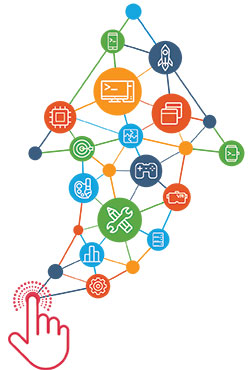
Digital transformation has been a popular buzzword over the last year as businesses try to navigate what the term truly means and how it can be achieved. Research firm Gartner refers to the digital transformation of a business as “the process of exploiting digital technologies and supporting capabilities to create a robust new digital business model.”
Over the last couple of years, everything has become digital, explained Geoff Perlman, founder and CEO of Xojo, a cross-platform application development tool provider. “Today, if it can be digital, it is. The result of that is that computers and solutions have become such a critical part of our business lives and personal lives.” Couple that with the ongoing need for speed, and a business ends up with a whole lot of complexity.
Businesses need to innovate faster and deliver high-quality solutions and features more frequently, but they can’t keep up with the supply and demand. “Businesses are unable to deploy the technological solutions that they need to continue to remain competitive, continue to service and delight their customers and employees alike,” said Ben Saren, CEO of Dropsource, a low-code mobile development platform provider. To be able to successfully achieve all that, businesses have also been going through a parallel metamorphosis. The idea of implementing and applying low-code development to business strategies has become more appealing.
“Species have had to adapt or they went extinct. Technology is the new changing element that requires adaptation,” said Perlman. For instance, ride sharing services like Uber and Lyft have been taking over taxi businesses because of their ability to provide a well designed application. Blockbuster video pershied after it failed to adopt an online streaming service on time, Perlman explained.
“The thing people don’t realize is that most people work for small businesses, and the problem is that small businesses can’t usually afford to have an IT staff,” Perlman explained. The power of low-code is appealing because makes all this technology available to a broader set of people. “With a little bit of time to learn something new, non-technical people can solve a business problem without having to have an IT staff to do it,” he said.
Even if your business can afford an IT staff and development team, Perlman explains that there is always going to be way more more work to do than people to do it. “Historically, businesses have always had to prioritize and that meant some things that their customers and other people in other departments in their company wanted to do just didn’t get done because there wasn’t enough people,” he said. “Now with citizen developers and low-code, that burden can be lifted and it allows IT to prioritize the bigger things and it empowers other departments to no longer be reliant or dependent upon IT for everything.”
Empowering the people
Low-code solutions are more than just drag-and-drop, visual programming interfaces. The features tools possess can give businesses the power to answer a big part of the question of digital transformation, which is the ‘how?’ But before businesses embark on how they should approach low-code for their digital initiatives, they need to understand the why and the when, according to Jorge Sanchez, director of product strategy at Appian, an enterprise low-code and BPM software provider.
“It’s not just about the platform you build with, it is about the collaborative design and making sure you are mapping business objectives with the actual value that you are going to derive from the app,” he said. A good low-code platform provider will help you answer the why and when before jumping to the how, Sanchez explained.
Low-code platforms should also enable users to reuse components in a smart way. “Another reason that low-code platforms are really good at enabling digital transformation is because the speed of change keeps increasing,” said Sanchez.
In addition to reusing components, Xojo’s Perlman believes a platform should enable you to reuse your knowledge. Instead of having to take the time to learn the skills a certain environment targets such as JavaScript or HTML, it is a huge benefit if the solution allows you to apply the same skills to other platforms.
According to Dropsource’s Saren, some low-code tools provide no runtime platforms, meaning it doesn’t lock the business into anything and it gives them the freedom and control to develop and target different platforms as necessary. This is especially important in today’s digital transformation era as businesses now feel pressure to develop for all the variety of devices on the market.
Xojo’s Perlman explained some low-code solutions also offer a cloud offering that takes care of the security and maintenance so all the user has to do is press deploy. “This is huge for citizen developers, because they can get back to doing whatever it is that their job title says they need to do,” he said.
That, though, does require the user to have some level of trust with the platform, according to Sanchez. Businesses should understand the type of security and operational services a low-code tool is providing so they know what they have to worry about. Ideally, the tool should enable the user to focus on the feature they are delivering and manage the rest, Sanchez explained.
Low-code tools and initiatives should also cater to the average person, Xojo’s Perlman explained. While tools can help ease the pain for development teams, the majority of business users who are going to be using it are going to be non-technical people, Perlman explained. “Tools should enable incremental learning,” he said. “A lot of times, tools overwhelm the users with a number of menus and icons. If you start with a simple approach, and reveal things over time, it helps someone who is maybe not as technical to learn as they go.”
Additionally, Dropsource’s Saren warns against being fooled by big-name companies. He explained that a lot of people think if it comes from a popular company, it has more of a probability of sticking around for the long haul.
“Be open-minded and willing to look at solutions you might not have historically considered. The traditional and conventional approach is not working anymore, and these kinds of demands require out-of-the-box solutions,” he said. “Don’t make compromises with proprietary solutions that give you inferior results, inferior code or somehow lock you into extensive runtime environments. There are options out there and as more players enter this low-code space there are going to be more options for enterprises.”
Whether we call it digital transformation or not, we will continue to see this space play out over the next couple of years. “Digital transformation is just a constant evolution towards the latest and greatest technologies that the world has come to expect,” said Saren. “It is not just about bringing in new technologies, checking the boxes and saying okay we have a website or a mobile app. You have to continue to innovate.”
According to Appian’s Sanchez, if you think about software and what the industry has been trying to do throughout the years is it has been working to improve automation. For instance, pen and paper solutions have been replaced with computers and keyboards, and the transformation has been ongoing ever since. What has changed are the names and terms we use to describe it, Sanchez explained.
“The promise of software, which is improving the automation, is going to remain the same. The terminology might change. Today, we call it digital transformation. Tomorrow we might call it augmented reality transformation. It is all going to be with the same purpose: Improving automation, improving business outcomes and ensuring we reach our customers in a better, more successful way,” he said. “The whole premise of low-code is to help companies and organizations keep up with the ever-growing pains of change.”
Addressing digital transformation weakness: mobile app development
Low-code mobile development platform provider Dropsource revealed in the results of a recent survey that mobile was the “achilles heel” of digital transformation. According to the report, 84 percent of digital leaders feel like they are “behind the 8-ball” when it comes to developing mobile apps and supporting business goals. In addition, 25 percent of respondents stated they felt extremely behind the curve and 41 percent believe their inability to develop mobile apps is negatively impacting their ability to compete in the market.
“There is that urgency these businesses are feeling to get mobile solutions deployed into their customers’ hands, into their employees’ hands, partners’ hands etc.,” said Dropsource’s CEO Ben Saren. “It is only increasing, and their ability to move quickly is not there yet by and large.”
“Successful digital transformation today requires bold, next-level mobile innovation,” the report stated. “Technology changes fast, but mobile apps change faster, making digital transformation not only challenging, but immediate.”
Saren explained the problem is that development and IT teams are too often not brought into the conversation sooner. Instead, digital leaders and chief data officers expect their development teams to build something, when in reality teams are not well equipped to deploy those solutions. “The sooner development teams have a seat at the table, the better and more successful you are going to be at generating the kind of buy-in you need within your organization,” said Saren. “Digital leaders, IT and development teams need to work together in a more constructive way and with an open mind so they can come up with the appropriate compromises for solving the problem, because everyone will have to make compromises to get to the end result.”
Equipped with a low-code solution, developers can more easily deploy and maintain enterprise-class mobile apps without sacrificing quality, control, performance or user experience, and the elimination of manual development frees them up to work on top-level features, Saren explained.
“You have big goals, but live in limbo-land where expectations are high and yet there’s not often enough budget or understanding of what it really takes to succeed in mobile,” the report stated. “It’s time to admit you can’t keep doing things the same way, using the same tools and expect different results.”
Becoming a “10Xer”
Despite the many benefits low-code solutions promise, many professional developers are still hesitant about adding it to their toolbelt. A recent report from Evans Data found developers are slow to adopt low-code/no-code solutions.
“While low-code platforms enable speedier development of UI and other common elements through templates, frameworks, and visual design tools, they also put limitations on developers because the very nature of supplied components and methods implies a restriction to adhere to those supplied components and practices. Developers who may have spent many years perfecting their craft are hesitant to discard the flexibility they have when custom-coding their apps for the easier construction and quicker time to market that low-code platforms provide,” Evans Data stated in an email to SD Times.
However, Jorge Sanchez, director of product strategy for Appian, thinks professional developers are missing the point. According to Sanchez, low-code solutions can not only help developers become more productive, but it can help improve their craft.
There is a rare breed of programmers that are considered “10Xers.” “10Xers” are the Mark Zuckerbergs of the world that can build something like Facebook all by themselves, Sanchez explained. With the power of low-code, developers can speed up the process of coding, deploying scripts, and troubleshooting, and get back to what they really care about, which is building and delivering the application.
“If you like spending long nights and working all weekend just to keep up with everything that is happening, then sure, by all means do so. But if you can do more with less, why not work smarter instead of just harder?” said Sanchez. “If you can build a whole application in a matter of weeks, then there is more you can get to and less weekends you have to sacrifice. You can become a 10Xer yourself because there is so much assistance the platform is giving you.”






